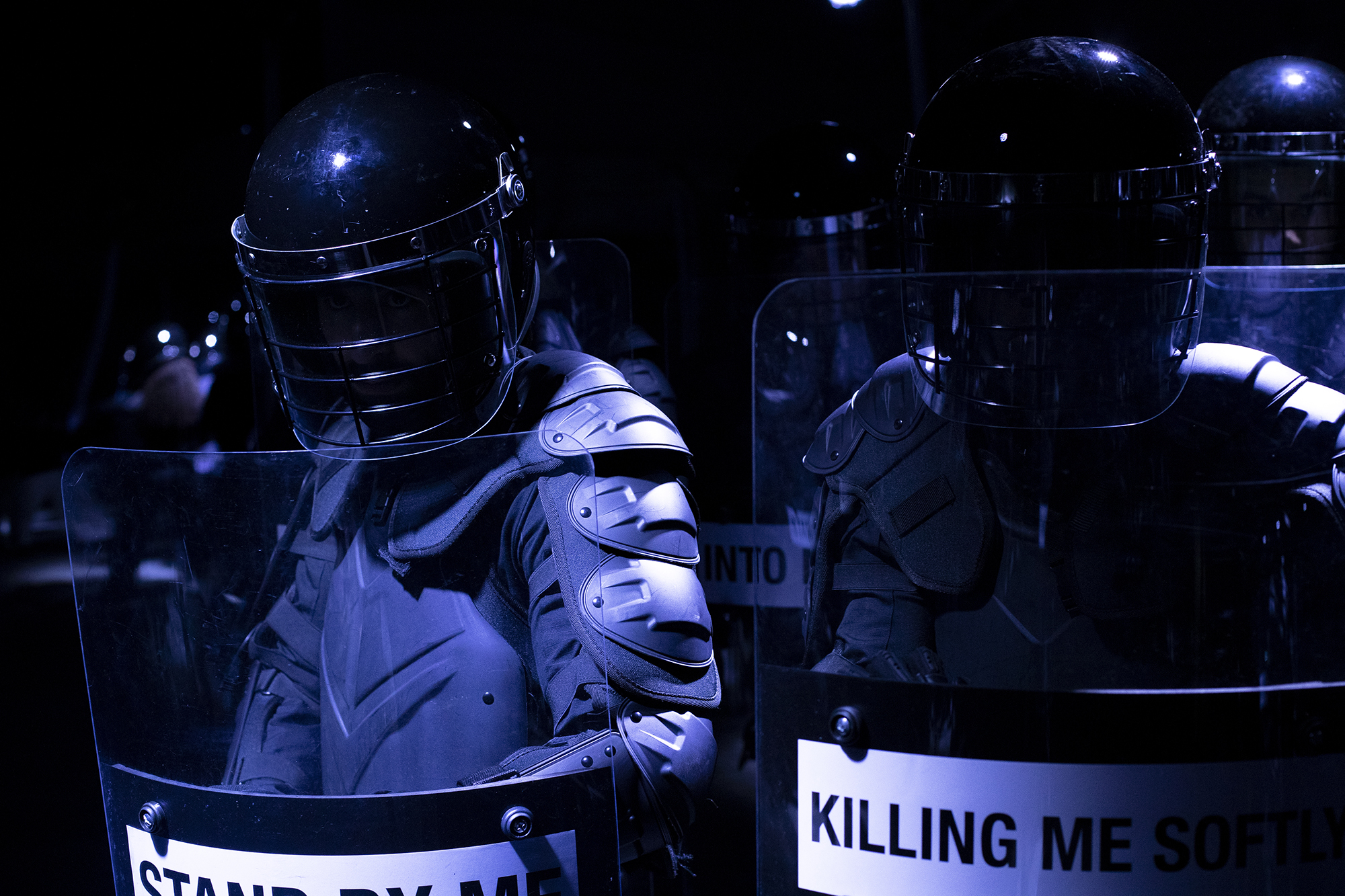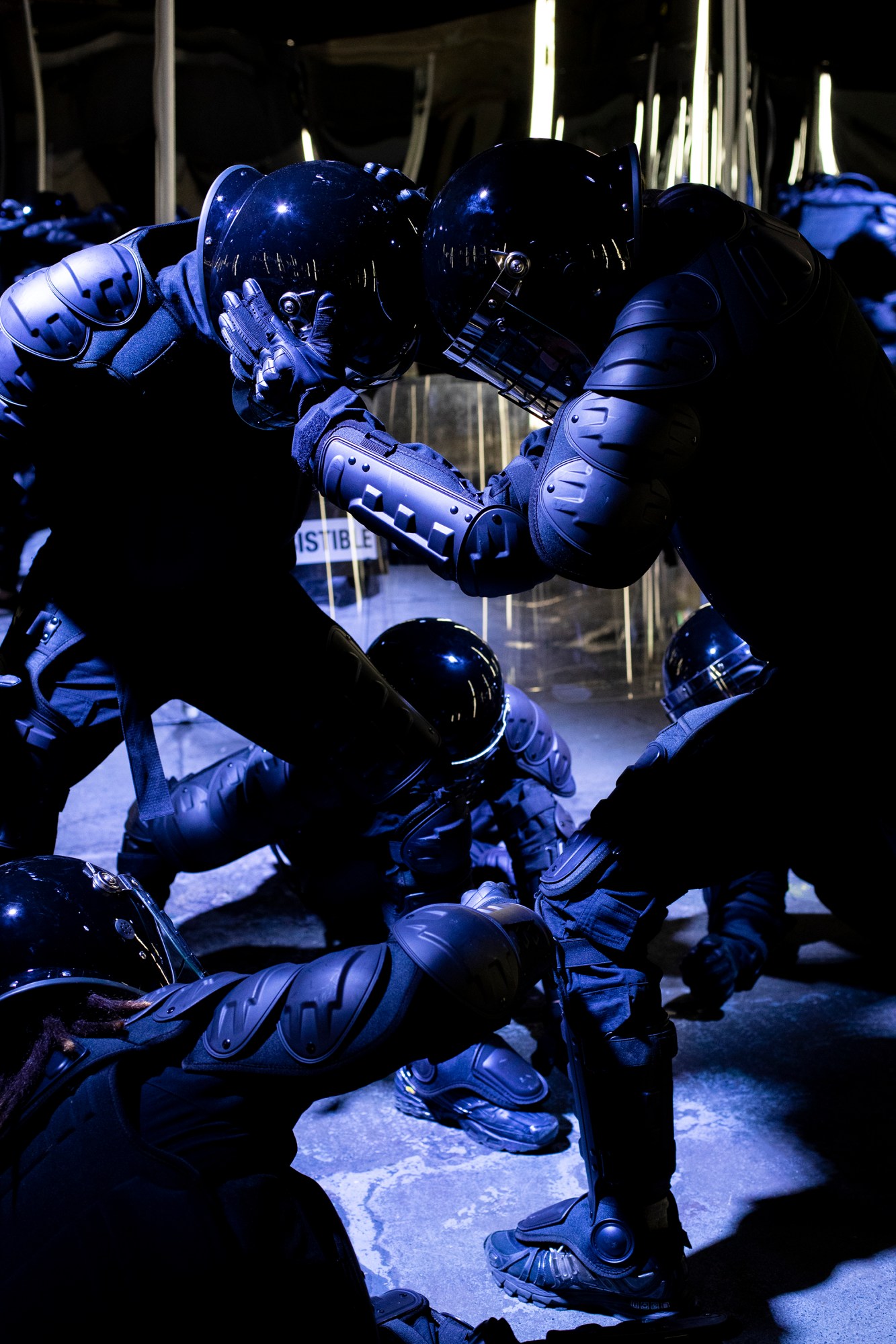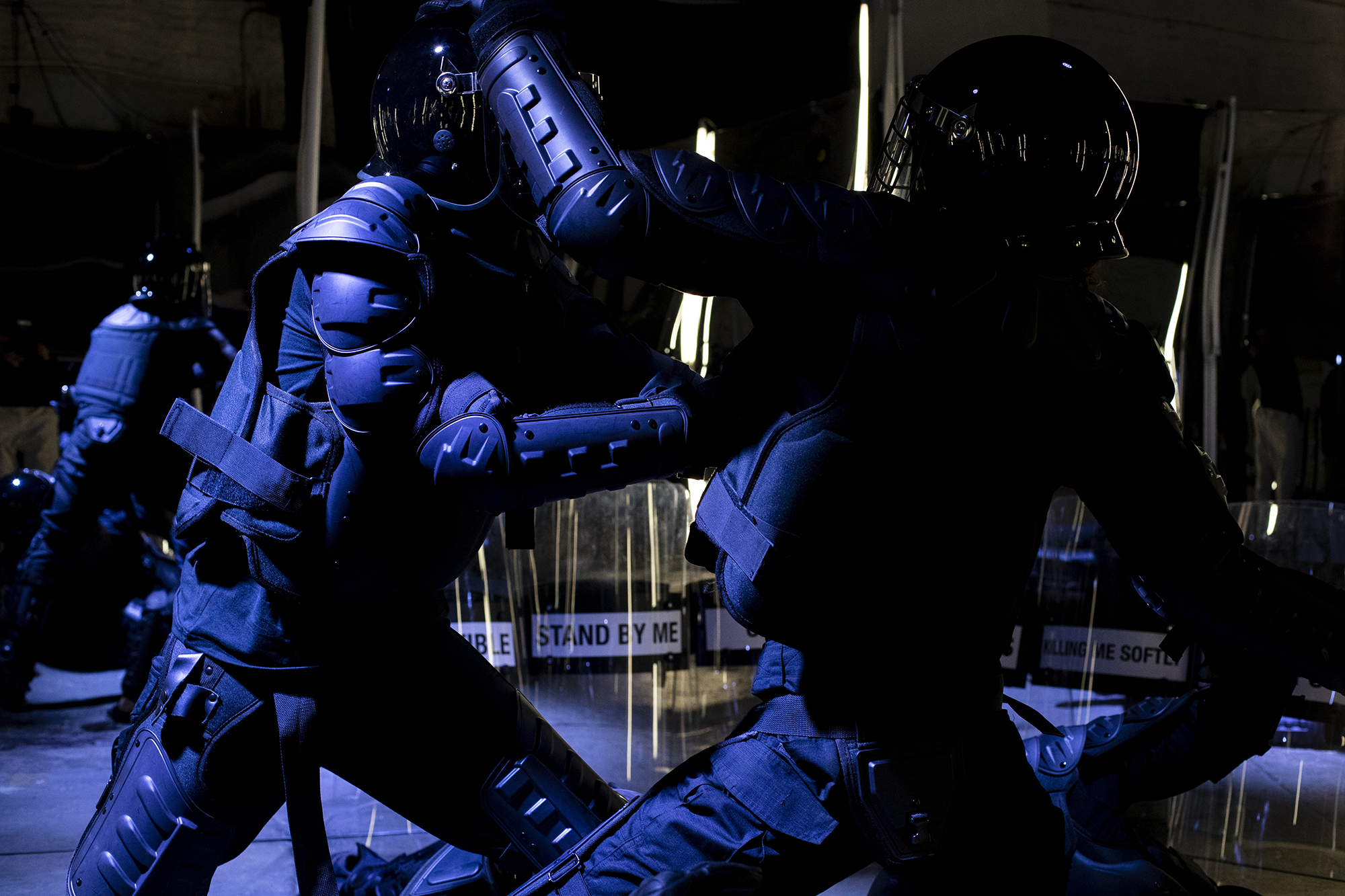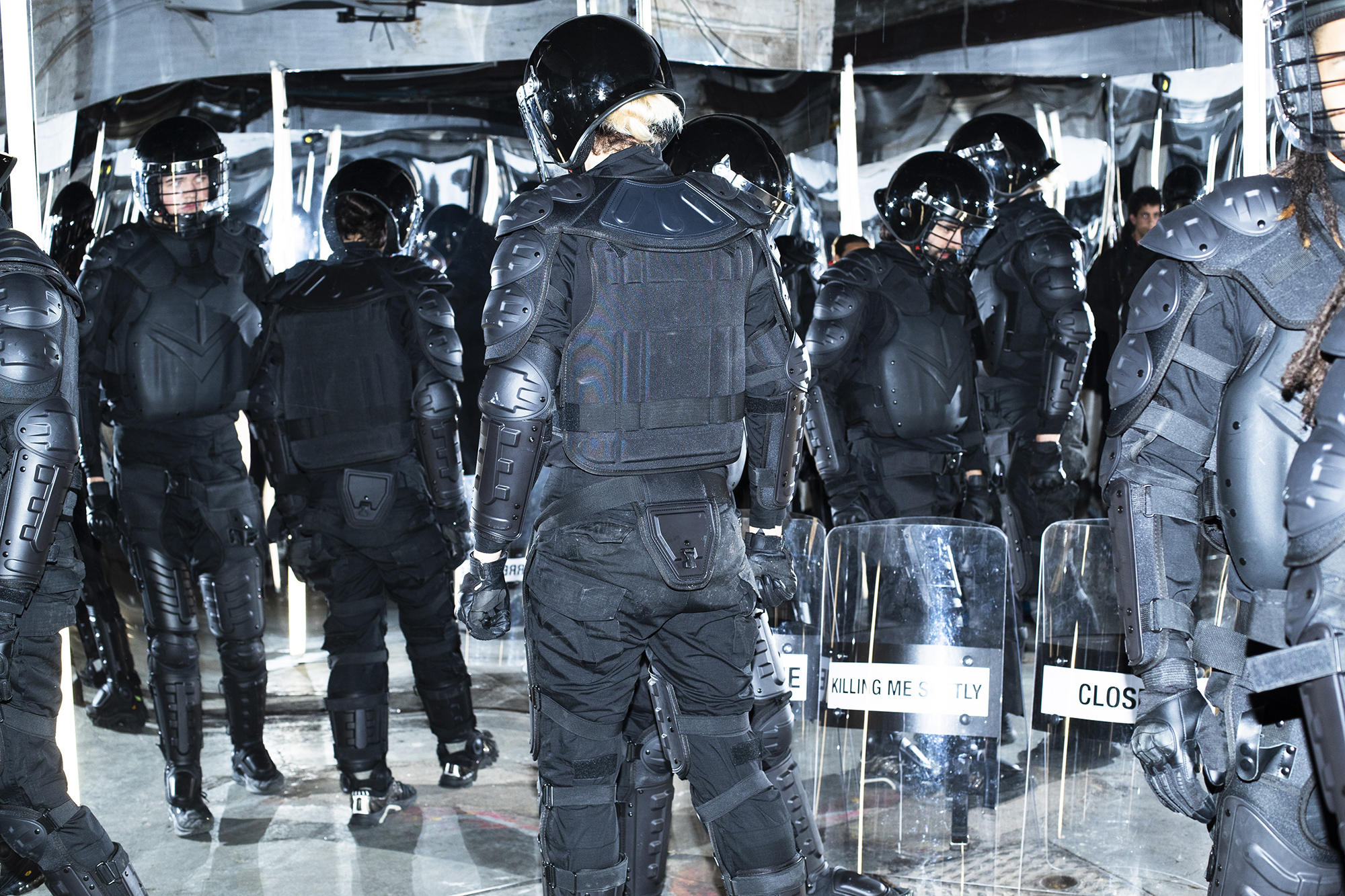I meet PentHouss — a self-described “conceptual multidisciplinary artist hub” led by artists Anna Lann and Yonathan Trichter and a series of collaborators — on a Sunday night, just before they began rehearsals for their new immersive artwork, CALL TO ARMS. Sat in the apartment of their London-based curator, Helen Neven, Brick Lane churns below the window as we talk. Weekend pub sessions are winding up, couples bicker as they pass, laughing teens drift by below on skateboards — and inside, Anna is telling me about the industrial-grade riot gear that has been hanging in her wardrobe for a few months now, bought from an internet retailer and available with the option of electric-shock stun shields.
The image of riot gear is a central pillar of this new work, which unfolds across three days in an industrial space in south London. Visitors arrive into a waiting room that hums with anticipation — a low and intense, lingering shadow of mechanical sound. Inside the next room, viewers are led into a hexagon of infinity mirrors containing a suspended, strobe-lit site of riot action. Six dancers, dressed in the ominous uniform of riot police, pulsate in motion — asserting their bodies in united formation, or charging at the visiting public. By implicating the audience in this simulation of frontline tensions, Helen explains that the work seeks to reflect “on the complex relationship between agents of power and the civilians they supposedly protect; on the instrumentalisation of fear; on the duality of ‘them’ and ‘us’ at street level.”

The project began to take seed over two years ago, with Yonathan having just relocated to Paris amidst the waves of the Gilets Jaunes movement. Anna had recently arrived in London, and not long after, the world was swept up into a series of protests — real action most often mediated through the framework of mass media and our own screens. Just last week, Amnesty International released a statement on the lack of justice for victims of police brutality during last year’s peaceful protests in Nigeria, which ended a year ago via a brutal crackdown by state security forces. The Guardian reported nearly 1,000 recorded instances of police brutality during the five months of anti-racism protests in the US last year. In the UK, the brutal murder of Sarah Everard — who was tricked into the car of an off-duty police officer, Wayne Couzens, through the abuse of his police ID, handcuffs, and training — was followed by a public vigil that ended with excessive force being used against female protesters.
All of these movements — whether for civil liberties or for climate action — saw the ubiquitous presence of state police and direct aggressions towards civilians. Made in collaboration with Turkish choreographer Ekin Bernay, who was inspired not only by personal experience of riot police in her home country but by her own father’s detainment for supposed dissidence, the exhibition experience has been actively designed to unsettle. “It doesn’t matter what country you’re coming from, or which background you’re from, or what your political beliefs are,” Anna says. “You look at [the riot gear], the design of this uniform, and you know exactly what it is.”

The PentHouss cast dance across a breadth of backgrounds and styles, including contemporary, with Helen noting that they put a particular emphasis on street styles such as krump, “which takes much of its inspiration from the movements of street fights,” she says. “The choreo also uses formations lifted directly from police training.” Both artists and curators remark on the fact that Ekin also works as a dance therapist and the sensitivity this brings to an immersive experience that, for some, will trigger memories of fear, oppression, intimidation, and direct violence. Yonathan tells me that they have been starting rehearsals with an open forum to explore “how the dancers feel putting on these uniforms, and be able to process doing this piece in a way that isn’t triggering, or disturbing,” he says. “Even though you know that they’re playing the part, it’s a strange experience.”
The use of mirrors and enclosed space creates an airlessness, putting the viewer in the middle of the action. The artists describe how the notion of crowd control “plays a big part in the choreography”. This was partly inspired by a realisation that very few people have experienced a riot (or riot police). Often, this brutality is mediated instead through the flatness of a computer screen or newspaper. As Yonathan notes, perhaps “you see it through a screen, and even though it’s sometimes shocking, when you see it once or twice, you become very cold to it.”

The team have all tried on the riot gear and note how it generates a certain disassociation in the wearer. Whether it’s the anonymising effect of the uniform or perhaps a feeling of physical invincibility, the work’s immersive mode goes some way towards both a psychological and kinetic portrait of these agents of power. Fundamentally, the team discovered that the uniform “really controls a lot of your feelings, your movement,” Anna says. “You almost can’t feel anything. We were practising falling on our knees, and you can do it 400 times, and you don’t feel anything, so this really affects your vulnerability and awareness of pain.”
PentHouss have long engaged with visions of a better future; utopian fictions that explore sprawling landscapes and expansive bodies whilst engaging themes of transformation, transgression and the infinite possibilities of post-digital identity. With this lurch towards a more visceral and dystopian investigation of contemporary power — “literally the reflection of reality” — they hope to evolve the project and tour it internationally. “What we want to do, in general, is to make this space based on testimonies of people’s own experience,” Anna says. “We’re going to learn a lot from these four days from the audience, from the dancers, from anyone involved; we’re going to gather all this information and use it as an input to change.”
Yonathan wonders about the project’s impact if politicians, army people, police people, the privileged could partake. “I would love actual politicians to experience this work, because I think the politician never went to the riot, you know, he only sees it from the top.” After the interview, Anna and Yonathan are heading home to anti-fog the performers’ riot helmets by hand ahead of rehearsals the next morning. It’s clear that their personal attachment to the project — with all its practical, personal, and thematic complexities — goes well beyond this installation. “We want to make people that are in a place of power experience the opposite.”

Credits
All images Daniel Jackont, courtesy of PentHouss

